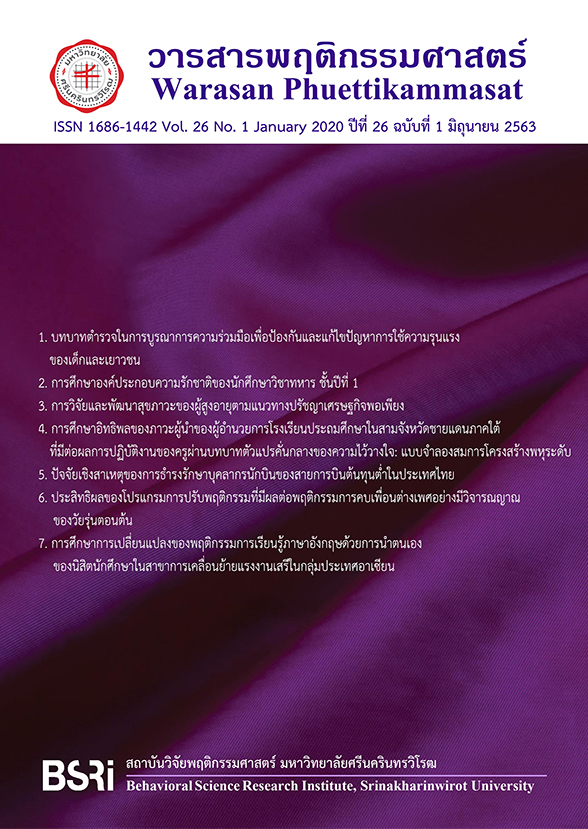การศึกษาการเปลี่ยนแปลงของพฤติกรรมการเรียนรู้ภาษาอังกฤษด้วยการนำตนเองของนิสิตนักศึกษาในสาขาการเคลื่อนย้ายแรงงานเสรีในกลุ่มประเทศอาเซียน
Keywords:
study of change, latent growth curve model, self-directed language learningAbstract
งานวิจัยครั้งนี้มีวัตถุประสงค์เพื่อพัฒนาและตรวจสอบโมเดลโค้งพัฒนาการที่มีตัวแปรแฝงของการเปลี่ยนแปลงระยะยาวของพฤติกรรมการเรียนรู้ภาษาอังกฤษด้วยการนำตนเองของนิสิตนักศึกษาในสาขาการเคลื่อนย้ายแรงงานเสรีในกลุ่มประเทศอาเซียน กลุ่มตัวอย่างเป็นนิสิตนักศึกษาชั้นปีที่สุดท้ายของหลักสูตรในแต่ละสาขาวิชาตามการจัดทำข้อตกลงยอมรับร่วมกันด้านคุณสมบัติในสาขาวิชาชีพหลักตามปฏิญญาว่าด้วยความร่วมมือในอาเซียน คัดเลือกกลุ่มตัวอย่างแบบสองขั้นตอน จำนวน 200 คน เก็บข้อมูลซ้ำ 3 ครั้ง ใช้เครื่องมือวัดเป็นแบบสอบถามจำนวน 2 ฉบับ วัดชุดเดิมกับกลุ่มตัวอย่างคนเดิม วิเคราะห์ข้อมูลโดยการสร้างและตรวจสอบโมเดลโค้งพัฒนาการที่มีตัวแปรแฝง (Latent Growth Curve Model) ผลการวิจัยพบว่า แบบจำลองโค้งพัฒนาการที่มีตัวแปรแฝงของพฤติกรรมการเรียนรู้ภาษาอังกฤษด้วยการนำตนเอง มีความสอดคล้องกับข้อมูลเชิงประจักษ์ โดยมีค่าChi-square (c2) = 5.99, df = 4, p = 0.200, RMSEA = 0.05, GFI = 0.98 และ NNFI = 0.29 และมีค่าสัมประสิทธิ์อิทธิพลของตัวแปรโค้งพัฒนาการที่มีต่อตัวแปรสังเกตเป็น 0, 1, 3.5 ในแต่ละช่วงเวลาตามลำดับ กล่าวคือ พฤติกรรมการเรียนรู้ภาษาอังกฤษด้วยการนำตนเองมีลักษณะการเปลี่ยนแปลงที่เพิ่มขึ้นอย่างมีนัยสำคัญทางสถิติ
Downloads
References
Angsuchoti, S., Wijitwanna, S. & Pinyopanuwat, R. (2011). sathiti wikhro̜ samrap kāntham wičhai thāng sangkhommasāt læ phrưttikam sāt : theknik kānchai prōkrǣm LISREL. Bangkok: Čharœ̄ndī Mankhongkānphim.
Association of Southeast Asian Nations: ASEAN. (2016). ASEAN Tourism Ministers to launch Tourism Skills Standards. Retrieved from https://asean.org/asean-tourism-ministers-to-launch-tourism-skills-standards/
Baker, L. & Brown, A. L. (1980). Metacognitive Skill and Reading Technical. (Research Report No. 188). Urbana III: Center for the study of Reading.
Bharathi, P. (2014). Self–directed Learning and Learner Autonomy in English Language Teacher Education: Emerging Trends. ELT Voices – India International Journal for teachers of English, 4(1), 1-9.
Brockett, R. G. & Hiemstra, R. (1991). Self-Direction in Adult Learning: Perspectives on Theory, Research, and Practice. London: Routledge.
Chumtanti, N. (2008). radap khwām phrō̜m nai kān rīanrū dūai kān chīnam tonʻēng khō̜ng nisit chan pī thī nưng wichā ʻēk phāsā ʻAngkrit [Self-directed learning readiness level of the first year students majoring in english]. Journal of Humanities Naresuan University, 5(2), 63-83.
Costa, A. & Kallick, B. (2004). Assessment strategies for self-directed learning. Thousand Oaks, CA: Corwin.
Du, F. (2013). Student Perspectives of Self-Directed Language Learning: Implications for Teaching and Research. International Journal for the Scholarship of Teaching and Learning, 7(2), 1-16.
Kline, R. B. (2011). Methodology in the Social Sciences. Principles and practice of structural equation modeling (3rd ed.). New York: Guilford Press.
Knowles, M. (1975). Self-Directed Learning. Chicago: Follet.
Knowles, M. (1998). The adult learner: The definitive classic in adult education and human resource development. Houston, Tex.: Gulf.
Kocaman, G., Dicle, A. & Ugur, A. (2009). A longitudinal analysis of the self-directed learning readiness level of nursing students enrolled in a problem-based curriculum. Journal of Nursing Education, 48(5), 286-290.
Littlewood, W. (1999). Defining and Developing Autonomy in East Asian context. Applied Linguistics. 20(1), 71-94.
Ministry of Education. (2011). laksūt kānsưksā naphư̄n thān Phutthasakkarāt sō̜ngphanhārō̜ihāsipsī. Bangkok: rōngphim ʻongkān rap song sinkhā læ phat duphan.
Moungpluan, C. (2011). kānphatthanā rūpbǣp kān rīan dūai tonʻēng dūai kitčhakam kān rūkhit nai kān ʻān phāsā ʻAngkrit naksưksā radap prakāsanīyabat wichāchīp chan sūng praphēt wichā ʻutsāhakam [Development of self-directed model in english reading using metacognitive activities for industrial diploma students]. Veridian E Journal Su., 4(1), 513-532.
Office of the Education Council. (1999). phrarātchabanyat kānsưksā hǣng chāt Phō̜.Sō̜. 2542. Retrieved from https://www.bic.moe.go.th/images/stories/Porrorbor2542.pdf.
Office of the Higher Education Commission. (2010). yutthasāt ʻudomsưksā Thai nai kāntē rī yom khwām phrō̜m sū kān pen prachākhom ʻĀsīan nai pī 2558. Bangkok: Hānghunsūančhamkat Bāngkō̜kblo̜k.
Office of the National Economic and Social Development Council. (2015). ( rāng ) phǣn phatthanā sētthakit læ sangkhom hǣng chāt chabap thī sipsō̜ng 2017-2021. Retrieved from https://www.nesdb.go.th/ewt_dl_link.php?nid=6422.
Office of the Permanent Secretary. (2012). rāingān kānsưksā chabap sombūn khrōngkān trīam kān rō̜ng rap kān khlư̄anyāi khō̜ng rǣngngān sū kān pen prachākhom ʻĀsīan. Bangkok: Chula Unisearch, Chulalongkorn University.
Rovinelli, R. J., & Hambleton, R. K. (1977). On the use of content specialists in the assessment of criterion-referenced test item validity. Dutch Journal of Educational Research, 2, 49-60.
Rojanabenjakun, P., Toopgrajank, S., & Charoenwiriyakul, C. (2018). patčhai thī mī phon tō̜ prasitthiphon kān rīanrū phāsā ʻAngkrit khō̜ng naksưksā nai radap ʻudomsưksā [Factors affect the effectiveness of learning english language on higher education students]. Journal of the Association of Researchers, 23(2), 203-214.
Schumacker, R. E. & Lomax, R. G. (2010). A beginner's guide to structural equation modeling (3rd ed.). New York: Routledge/Taylor & Francis Group.
Seehaboolee, C. (2016). khwām phrō̜m khō̜ng naksưksā Thai nai talāt rǣngngān ʻĀsīan. Research and Development Newsletter, 15(164), 12-19.
Tasee, P. (2008). laksana thāng čhit læ saphāpwǣtlō̜m thāngkān rīan thī kīeokhō̜ng kap khwām phrō̜m nai kān rīanrū dūai kānnam tonʻēng khō̜ng naksưksā chan pī thī nưng khō̜ng mahāwitthayālai nai Krung Thēp Mahā Nakhō̜n [Psychological characteristics and learning environment related to self-directed readiness of first-year university students in bangkok metropolis]. (Master’s thesis). Srinakharinwirot University, Bangkok.
The Department of ASEAN Affairs, Ministry of Foreign Affairs. (2013). ASEAN Mini Book. Bangkok: Page Maker Co., Ltd.
University of Iceland. (2016). Self- directed language learning. Retrieved from https://english.hi.is/university/self_directed_language_learning.
Ushioda, E., & Ridley, J. (2002). Working with the European Language Portfolio in Irish Post-primary Schools: Report on an Evaluation Project. CLCS Occasional Paper No.61. Dublin: Trinity College, Centre for Language and Communication Studies.
Wiratchai, N. (1999). mōdēnlitrēn: sathiti wikhro̜ samrap kānwičhai. Bangkok: Chulalongkorn University Printing House.
Woothiwongsa, N. (2014). konlayut sāng rǣng čhūngčhai: kānphatthanā thaksa phāsā ʻAngkrit [Motivational strategies: enhancing english language skills]. Executive Journal, 34(1), 89-97.
Downloads
Published
How to Cite
Issue
Section
License
Behavioral Science Research Institute, SWU
114 Sukhumvit 23, Bangkok 10110, Thailand.
Tel.02-649-5000 # 17600



